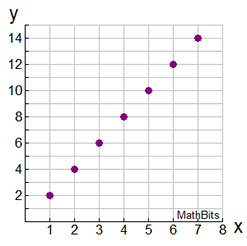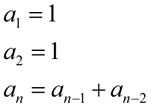A list of terms
that form a pattern is referred to as a sequence.
Some patterns are easy to see, while others are more difficult to decipher.
Consider the following sequences and their patterns:
| Sequence |
Pattern |
 2, 4, 6, 8, 10, 12, 14, ... 2, 4, 6, 8, 10, 12, 14, ... |
each term is 2 more than the previous term |
 1, 5, 9, 13, 17, 21, ... 1, 5, 9, 13, 17, 21, ... |
each term is 4 more than the previous term |
 2, 4, 8, 16, 32, 64, ... 2, 4, 8, 16, 32, 64, ... |
each term is 2 times the previous term |
Not all lists of numbers form a pattern. There may be no relationship between the numbers.
The numbers may be simply a random list of numbers, such as:  3, 11, 18, 22, 23, 40 3, 11, 18, 22, 23, 40
Trying to Find the Pattern: |
Unfortunately, there is no magic way to arrive at a description of a pattern.
You need to be a detective and examine the terms and what is happening between the terms. Some patterns will be a challenge to discover.
Investigative hints:
How do you get from one term to the next term in a sequence?
Is the relationship the same between all successive terms? |

|
Sequence |
Observations |
Pattern |
 2, 4, 6, 8, 10, ... |
|
"2 is added to each
previous term" |
 3, 9, 27, 81, ... |
|
"3 is multiplied times
each
previous term" |
 3, 11, 19, 27, ... |
|
"8 is added to each
previous term" |
In the next sequence, it is difficult to see the pattern. Adding a single number will not work.
Multiplying by a single number will not work. This pattern is a combination of multiplying and adding. |
 2, 5, 11, 23, 47, ... |
|
"multiply each previous
term times 2 and add 1" |
A pattern where a single number is added to each previous term is called an arithmetic sequence.
A patterns where a single number is multiplied by each previous term is called a geometric sequence.
Numbering Locations in Sequences: |
When examining a list of numbers that form a pattern, it is often helpful to think about each term's position (location) in the list. For example, is a term the first number in the list? the third number in the list? or the tenth number in the list? The number (location) of a term is always a natural number, {1, 2, 3, 4, 5, 6, 7, 8, ...}.
Number of term (location) x |
1 |
2 |
3 |
4 |
5 |
6 |
7 |
Term in the sequence y
|
2 |
4 |
6 |
8 |
10 |
12 |
14 |
Different Ways to Express Patterns: |
 State the pattern based upon previous terms: State the pattern based upon previous terms:
This sequence can be described by its pattern: "each new term is formed by adding two to the previous term of the sequence".
 Graph pattern: Graph pattern:
|
|
Each term's location can also be used to create a graph of the sequence. The graph is a scatter plot. Do not connect the dots.
|
|
 (x,y) = (location, term)
(x,y) = (location, term)
|
|
 Create an equation for the pattern: Create an equation for the pattern:
In this sequence, we can also use each term's location to create an equation: y = 2x
where x is the number location of the term and y is the term itself in the sequence.
An advantage of the "equation" is that the 150th term can be found very quickly by plugging 150 into the equation. y = 2(150) = 300. The 150th term of this sequence is 300.
|
Sequence Notation: an = 2n where n belongs to the set {1,2,3,4,5,...}.
Term: |
2, |
4, |
6, |
8, |
10, |
12, |
... |
Notation for location: |
a1 |
a2 |
a3 |
a4 |
a5 |
a6 |
|
|
|
a1 = 2
a2 = 4
a3= 6 and so on. |
 Types of Equations: Types of Equations:
When a pattern is expressed as "how to get the next term based upon the previous term", it is called recursive. It can be described in words, or it can use a fancy formula such as
a1 = 2 and an = 2 • an - 1 for the sequence 2, 4, 8, 16, ...
When a pattern is expressed in relation to each term's location in the sequence, it is called explicit or functional. It can be described using an equation in terms of x and y, (x,y), or in terms of an and n, (n, an). The term's location is either x or n, and the term is either y or an.
Sequence |
Recursive Pattern |
Explicit (Function) Equation |
 2, 4, 6, 8, 10, ... |
"2 is added to each
previous term" |
y = 2x ; y = term, x = location
an = 2n ; an = term, n = location |
 3, 9, 27, 81, ... |
"3 is multiplied times
each
previous term" |
y = 3x
an= 3n |
 3, 11, 19, 27, ... |
"8 is added to each
previous term" |
y = 3 + 8(x - 1) = 8x - 5
an= 3 + 8(n - 1) = 8n - 5 |
 5, 7, 11, 19, 35, ... |
a1 = 5
an = an - 1 + 2n - 1 |
y = 3 + 2x
an= 3 + 2n
|
There are always sequences that stretch one's investigative skills.
The patterns may seem obvious after seeing them,
but initially finding them may seem impossible.
Let's look at two of these more challenging sequences. |
 |
 1, 4, 9, 16, 25, 36, 49, ... 1, 4, 9, 16, 25, 36, 49, ... |
|
This is not arithmetic since the same number is not added each time. |
Solution one:
based on what is being added:
The numbers being added are the sequence of odd numbers.
Description: "each new term is found by adding the next odd number." |
Solution two:
based on each term's location
1 2 3 4 5 6 7
 1, 4, 9, 16, 25, 36, 49, ... 1, 4, 9, 16, 25, 36, 49, ...
Multiply each term's location
times
itself to get the sequence
term.
Each term in this sequence is the
"square" of its number location. |
1 × 1 = 1
2 × 2 = 4
3 × 3 = 9
4 × 4 = 16
5 × 5 = 25
6 × 6 = 36
7 × 7 = 49 |
|
 1, 1, 2, 3, 5, 8, 13, 21, ... 1, 1, 2, 3, 5, 8, 13, 21, ... |
This famous sequence of numbers is called:
Fibonacci Sequence
|
The pattern:
Starting with the third term, add the previous two terms together.

|
 (starting with n = 3)
(starting with n = 3) |
|
|